|
Summary: On Sunday morning,
Dec. 30th, the full Moon dipped into the outskirts
of Earth's shadow;
southern portions of the Moon noticeably dimmed for about an
hour centered on 10:29 UT. North American and
Pacific sky watchers were best-located to see this subtle "penumbral" lunar eclipse.
The eclipse itself was subtle, but the Moon's close encounter
with Jupiter at the same time was dazzling. During the eclipse,
the two were less than 6 Moon-widths apart. At closest approach
five hours later (15:30 UT) the Moon passed a scant
0.5 degrees (one Moon-width) from the brilliant planet.
All
images below are copyrighted by the photographers.
Submit your photos,
too!
|
|
Photographer, Location |
Images |
Comments |
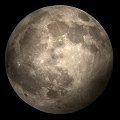 |
Les Marczi,
Welland, Ontario, Canada
10:45 UT |
#1 |
L. Marczi captured this
picture of the shadowed Moon from his front porch, about 15 minutes
after maximum eclipse. He used a Nikon 995 digital camera mounted
afocally on a 90mm Maksutov-Cassegrain telescope with a 35 mm
eyepiece. |
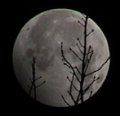 |
Eric
Pauer, Brookline, New Hampshire,USA |
#1, #2 |
E. Pauer: "I ventured
out in the cold Sunday morning around 5:30 am EST to take a few
snapshots of the moon with my Sony TRV720 Camcorder, using its
25X optical zoom. The moon, in the west at about 15 degrees altitude,
was just above the trees in my backyard here in southern New
Hampshire. I could definitely notice the subtle shading on the
lower left limb of the moon. " |
 |
Schindler
Leung, Hong Kong |
#1 |
By comparing the appearance
of the Moon during and 45 minutes after maximum eclipse, these
two photos reveal how Earth's shadow dimmed the lunar landscape
south of Tycho. A larger
version of the image is labeled with photo details. |
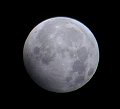 |
Stan
Richard, Urbandale, Iowa, USA |
#1,
more |
S. Richard: "This
was about as subtle an eclipse as I have ever seen. Unless you
knew it was happening you wouldn't even notice --b but you can
see the slight shading in the lower left. I shot this [during
maximum eclipse] at 4:30am CST using my Nikon 950 through binoculars." |
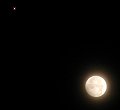 |
Bob Sandy,
Salem, Virginia, USA |
#1 |
B. Sandy: "This was shot with a Nikon 880
digital camera with a 3x telephoto. It was variably cloudy here
during the eclipse. I waited for a thin cloud to pass in front
of the Moon to dim it down so both Jupiter and the Moon would
be properly exposed." |
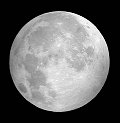 |
Phil
Harrington, Smithtown, New York, USA
10:30 UT, Dec. 30 |
#1,
#2, more |
P. Harrington: "Some subtle shading is evident
in the region of Tycho, which closely matched the visual impression.
Indeed, had I not known that an eclipse was occurring, I doubt
I would have noticed much difference in the Moon's appearance.
Certainly, it's teaming with Jupiter was far more visually interesting
than the eclipse. Each was shot afocally with an Olympus D-360L
digital camera through my 4-inch f/10 Celestron/Vixen C102 refractor
teamed with a 22-mm Tele Vue Panoptic eyepiece." |
 |
Bart Veltman,
Duiven, the Netherlands
19:57 UT, Dec. 30 |
#1 |
Hours after the eclipse,
B. Veltman captured this image of the Moon, Jupiter, and a glowing
contrail using a Nikon Coolpix 880 digital camera. |
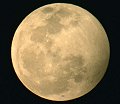 |
James Kevin
Ty, Manila , the Philippines
10:12 UT, Dec. 30 |
#1 |
Photo details: Nikon Coolpix
995 attached to a Televue TV-101 f/5.4 apo-refractor with Panoptic
35mm eyepiece; exposure time: 1/100sec. |
 |
Schindler
Leung, Hong Kong |
#1 |
This series of photos
compares the subtle shadings
of the Dec. 30th penumbral eclipse with the appearance of an
un-dimmed full Moon. |
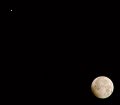 |
Thomas
Sundstrom, Vincentown, New Jersey, USA
10:29 UT, Dec. 30 |
#1 |
Jupiter appears in the
upper left corner of this image, which was captured at 10:29
UT. Photo details: Olympus C-2100UZ, eff 1000 mm, 1/60 sec. |
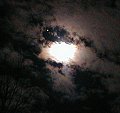 |
Cliff Smith,
Jackson, Mississippi, USA |
#1, #2 |
Some hours after the eclipse, Cliff Smith used
an Olympus digital camera (D340R) to record the close encounter
between Jupiter and the Moon; the pair were so bright that they
could be seen through clouds! |
More images
(click
on the name of the photographer to view the image):
Philip
Brogan
(Concord, New Hampshire); Becky Ramotowski (San Antonio, Texas);
Wayne
Davison
(Edmonton, Alberta, Canada)
back
to spaceweather.com |









